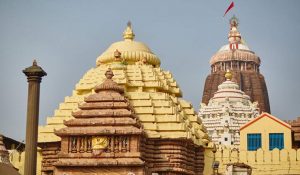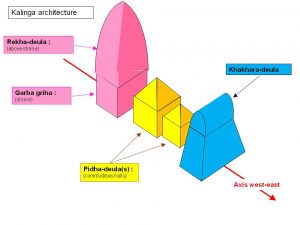Jagannath Temple, Puri
About
- Sri Jagannath Temple is one of the most revered and sacred pilgrimage sites in India.
- Its main deity is Lord Jagannath, who is said to be an incarnation of Lord Vishnu.
- There are two other deities, Lord Balabhadra and Devi Subhadra.
- The Jagannath Puri Rath Yatra is considered as India’s biggest chariot festival.

- The majestic temple is said to have been built by king Anangabhimadeva, also known as Angangabhima III of the Ganga dynasty.
- Some historians say the construction of the temple began during the reign of king Anantavarman Chodagangadeva, the founder of the dynasty, in the 12th century.
Architecture of the temple
- The temple is built in the Nagara style (Sub-school: Kalinga or Odisha school) of temple architecture.
- The temple consists of four structures: Vimana or Bada Deula (sanctum sanctorum), Jagamohana or Mukhasala (the porch or mandap), Natamandir (the audience hall) and Bhogamandap (bhoga is the food offering made to gods).
- The Vimana is in the style of Rekha deul– characterised by curvilinear tower known as Shikhara.
- The Jagamohana is in the form of Pidha deula- square building with a pyramid-shaped roof.
Other details
- It is built on a gigantic raised platform, Vimana on a pancharatha ground plan and is 65-m-high.
- The temple complex is enclosed within two concentric walls, the Kuruma Bheda (inner wall) and the Meghnad Pachira (wall).
- Also revered is the Aruna stambha or the Sun pillar, the 33-ft-high monolithic pillar of black chlorite in front of the main entrance.
- The capital of the pillar is surmounted by a squatting Garuda (the mythological bird mount of Lord Vishnu).
About Kalinga school of architecture
|
Why in News?
The Supreme Court has modified its earlier order and allowed the annual Jagannath Rath Yatra in Odisha’s Puri to be held with the coordination of the Temple committee, State and Central government without compromising with the health issue pertaining to Covid-19.
Subscribe
Login
0 Comments

